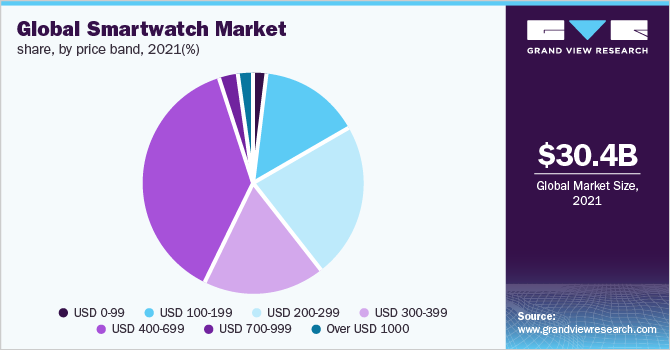Smartwatch Market Innovations: New Features Revolutionizing Wearables
The global smartwatch market was valued at USD 30,434.1 million in 2021 and is projected to grow to USD 71,565.3 million by 2030.
The global smartwatch market was valued at USD 30,434.1 million in 2021 and is projected to grow to USD 71,565.3 million by 2030, registering a compound annual growth rate (CAGR) of 8.2% from 2022 to 2030. This growth is primarily driven by the increasing demand for fitness tracking and health monitoring features integrated into smartwatches.
Manufacturers are equipping smartwatches with advanced health-related functions, including blood oxygen (SpO2) sensors, stress tracking, electrocardiograms (ECG), calorie tracking, and more. Prominent players such as Samsung, Noise, Fitbit, and Fossil Group, Inc. are actively developing devices focused on health monitoring. A notable example is the Apple Series 7, launched in September 2021, which includes features like native sleep tracking, ECG monitoring, blood oxygen saturation tracking, enhanced fall detection, and heart health monitoring.

Smartwatches also serve as versatile wearables that offer functions like calling and messaging, GPS navigation, voice assistance, and connectivity with other devices, allowing users to streamline and automate everyday tasks. Advancements in operating systems and user interface (UI) design have significantly improved performance and responsiveness. For instance, in June 2021, Garmin International Inc. released the Forerunner 945 LTE, a triathlon-focused smartwatch featuring LTE connectivity and GPS tracking, highlighting ongoing innovation in the sector.
Order a free sample PDF of the Smartwatch Market Intelligence Study, published by Grand View Research.
Key Market Trends & Insights
- North America led the smartwatch market in 2021, accounting for over 44.0% of the global revenue. This dominance is largely due to the popularity of Apple’s smartwatch series, early product launches, and high levels of technology adoption across the region. Europe and the Asia Pacific followed in market share.
- Based on price band, the USD 200–299 segment held the largest market share at 22.6% in 2021. Key vendors in this range include Apple Inc., Samsung Electronics Co., Ltd., Huawei Technologies Co., Ltd., and Fitbit, Inc. Apple Inc. led the market with a share of over 30.0% and is expected to maintain its leadership position through the forecast period.
- In terms of display technology, OLED-based smartwatches accounted for more than 91.5% of the market in 2021. Despite their higher manufacturing cost compared to LCDs, OLED displays offer superior clarity, responsiveness, and energy efficiency. Their prior use in smartphones and televisions has enabled manufacturers to assess demand and scale up production efficiently, reducing overall costs through mass manufacturing.
Market Size & Forecast
- 2021 Market Size: USD 30,434.1 Million
- 2030 Projected Market Size: USD 71,565.3 Million
- CAGR (2022-2030): 8.2%
- North America: Largest regional market in 2021
- Europe: Fastest growing regional market
Key Companies & Market Share Insights
Leading players in the smartwatch market include Apple Inc., Samsung Electronics Co., Ltd., Huawei Technologies Co., Ltd., Fitbit, Inc., and Garmin Ltd. These companies dominate the market by continuously improving the integration of smartwatches with smartphones and connected devices, offering enhanced software updates, and delivering seamless user experiences.
While these global tech giants remain dominant, they face growing competition from traditional watchmakers like Fossil, Swatch, and Tag Heuer, who are focusing on hybrid smartwatches that combine classic designs with smart features. At the same time, affordable smartwatches from Chinese and Indian brands are gaining market share by offering similar features at lower prices, posing a challenge to premium brands in terms of value and accessibility.
Key Players
- Apple Inc.
- Samsung Electronics Co., Ltd.
- Fitbit, Inc.
- Garmin Ltd.
- Fossil Group, Inc.
- Huami Co., Ltd.
- Huawei Technologies Co., Ltd.
Explore Horizon Databook – The world's most expansive market intelligence platform developed by Grand View Research.
Conclusion
The smartwatch market is evolving rapidly, fueled by a global shift toward health-conscious lifestyles and connected digital experiences. With a projected CAGR of 8.2% between 2022 and 2030, the market is set for steady expansion. Consumers are increasingly seeking devices that not only offer communication and convenience but also deliver advanced health tracking capabilities. The rise of OLED displays, feature-rich mid-range models, and the competition from both tech leaders and traditional watch brands are shaping a dynamic and competitive market landscape. As technology continues to advance, smartwatches are expected to become an even more integral part of personal health, fitness, and daily life.